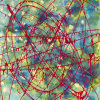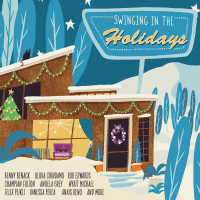Home » Jazz Musicians » John Fahey
John Fahey
John Fahey - acoustic guitar (1939 - 2001)
Acoustic guitarist John Fahey was impossible to classify. His eclectic music included traditional-sounding folk pieces, Indian ragas, blues, and unpredictable modern works, not fitting securely into any specific category but somehow always sounding personal.
John Fahey was born on February 28, 1939 in Takoma Park, Maryland. His father played popular songs on the piano and Irish harp, and his mother was also a pianist. John spent his youth raising wood turtles and fishing in the Susquehawa River and upper Chesapeake Bay. On Sundays the family went to the New River Ranch in nearby Rising Sun, MD where they heard the top country and hillbilly groups of the day, like Bill Monroe and The Stanley Brothers. On a fishing trip in 1952 John met a black singer and guitarist named Frank Hovington, whose fingerpicking style so intrigued John that he bought his first guitar soon thereafter, a Sears Roebuck model that cost him $17.00, and started teaching himself to play.
In 1959 while at college, he recorded an album, using as his name Blind Joe Death, and pressing only 95 copies. After getting a B.A. in Philosophy and Religion from American University, Fahey moved to Berkeley, California in 1963, where he established his own label, Takoma Records, and began his long recording career. The following year he moved to Los Angeles, got an M.A. in Folklore and Mythology from UCLA, and was instrumental in the rediscovery of blues artists Skip James and Bukka White. He expanded the Takoma label to include fellow guitarists Leo Kottke and Peter Lang, among many others, and New Age pioneer George Winston was another whose early career was nourished by the quirky innovator.
In recent years the Takoma catalog has been purchased by Fantasy Records of Berkeley, CA, and Fahey's Takoma LPs are now being systematically reissued on CD. Fantasy Records executive Bill Belmont called Fahey “a true American musical genius.”
Fahey performed instrumentals that, because of his use of space and atmosphere, hinted at New Age a couple of decades before that genre was born, but his music generally contained much more variety and expressed quite a few different moods, often unpredictably.
The reissue called “The Legend of Blind Joe Death” includes all but one of the songs from the original 1959 recording although some are remakes from 1963 and 1967 (a few numbers are heard twice) because Fahey felt that his technique had greatly improved. Even on these early compositions, Fahey’s approach to playing blues and folk music was quite unique and his guitar tunings were unusual. “The Transfiguration of Blind Joe Death” is another early set that keeps one guessing, alternating moods constantly.
Read moreTags
John Fahey: The Best of John Fahey, volume 2, 1964-1983

by Charlie B. Dahan
It seems one of the happiest days in John Fahey’s life was the day he was included in Spin magazine's guide to “Alternative Music," which included biographies about such artists as Nirvana, the Pixies and Joy Division. This listing finally validated that someone understood him and his musical career. Often lumped into the categories of “folk revivalist," or even worse, “father of new age guitar," Fahey simply played his guitar with raw emotion and soul. Fahey's compatriot ...
Continue ReadingJohn Fahey: Days Have Gone By

by Derek Taylor
John Fahey’s death from medical complications earlier this year was a shock to many of his loyal listeners, but in the context of the commercial music world his passing went largely unnoticed. A prime reason for this disparity of awareness originates in Fahey’s resolute refusal to play the commercial music game and in many instances to openly (and cleverly) mock it. One of his earliest ruses was the invention of an alter ego for himself (the legendary itinerant bluesman Blind ...
Continue ReadingJohn Fahey: Vol. 4 - The Great San Bernadino Birthday Party and Other Excursions

by Glenn Astarita
Vol. 4 - The Great San Bernadino Birthday Party and Other Excursions represents archival material culled from the early to mid-60’s by legendary acoustic guitar pioneer John Fahey who melded traditional Americana type themes with a deeply personalized vernacular. On the nineteen-minute title track, the guitarist combines grassroots style picking with odd tunings, unorthodox phrasing and keen utilization of space and depth. Yet Fahey also experimented with EFX back in those days which is evident on “Knott’s Berry Farm Molly”, ...
Continue ReadingJohn Fahey: Vol. 4 - The Great San Bernadino Birthday Party and Other Excursions

by Glenn Astarita
Vol. 4 - The Great San Bernadino Birthday Party and Other Excursions represents archival material culled from the early to mid-60’s by legendary acoustic guitar pioneer John Fahey who melded traditional Americana type themes with a deeply personalized vernacular. On the nineteen-minute title track, the guitarist combines grassroots style picking with odd tunings, unorthodox phrasing and keen utilization of space and depth. Yet Fahey also experimented with EFX back in those days which is evident on “Knott’s Berry Farm Molly”, ...
Continue ReadingJohn Fahey: The Great San Bernadino Birthday Party

by Derek Taylor
Relatively few musicians can lay claim to creating an entire school of music. John Fahey is among the number who can though his reclusive nature has often been at odds with the accompanying celebrity his earlier innovations engendered. Fahey gathered the seemingly disparate genres of European classical, country blues, religious music and even free improvisation, and brewed them into his own alchemical mead called American Primitive. Central to the early incarnations of his signature style was the steel string acoustic ...
Continue Reading

































